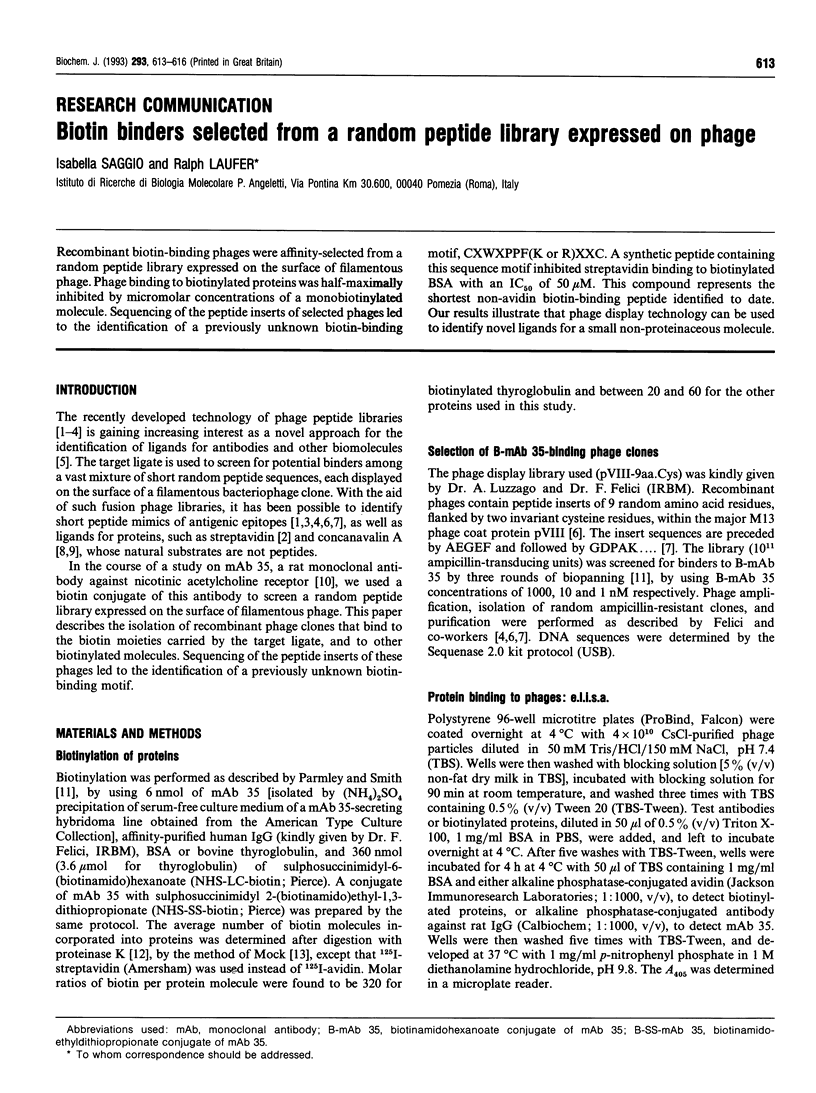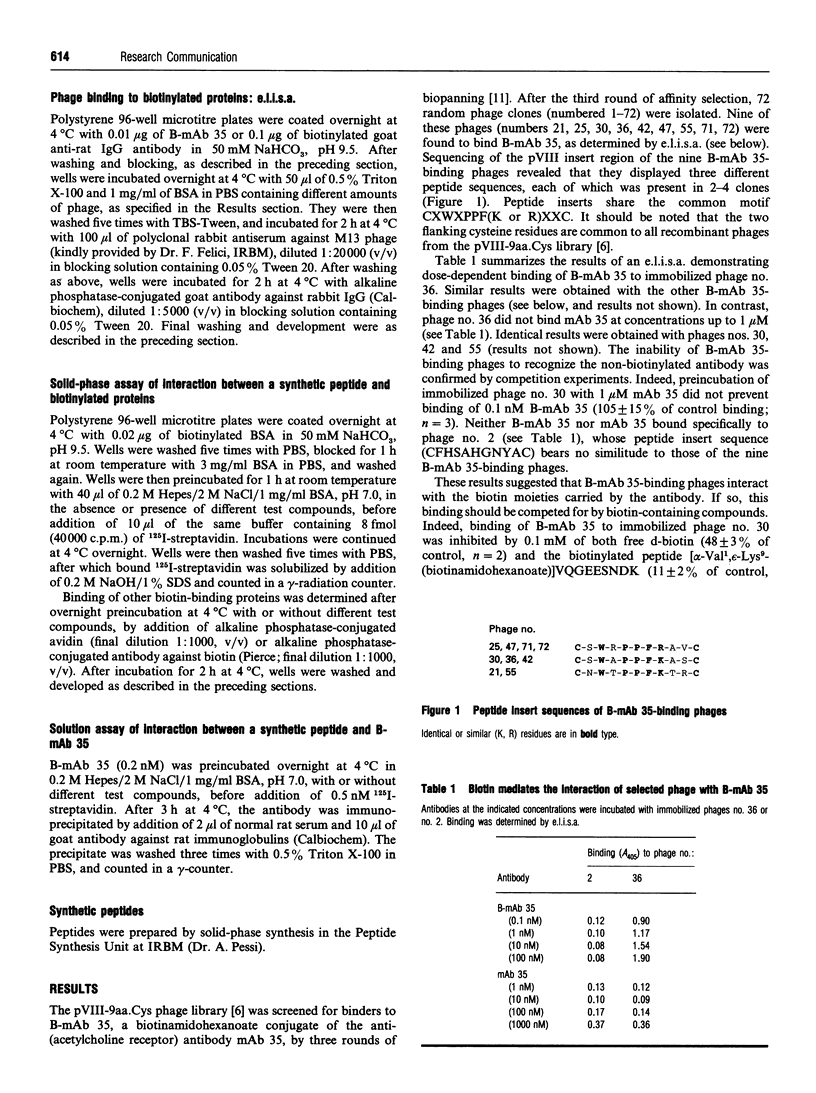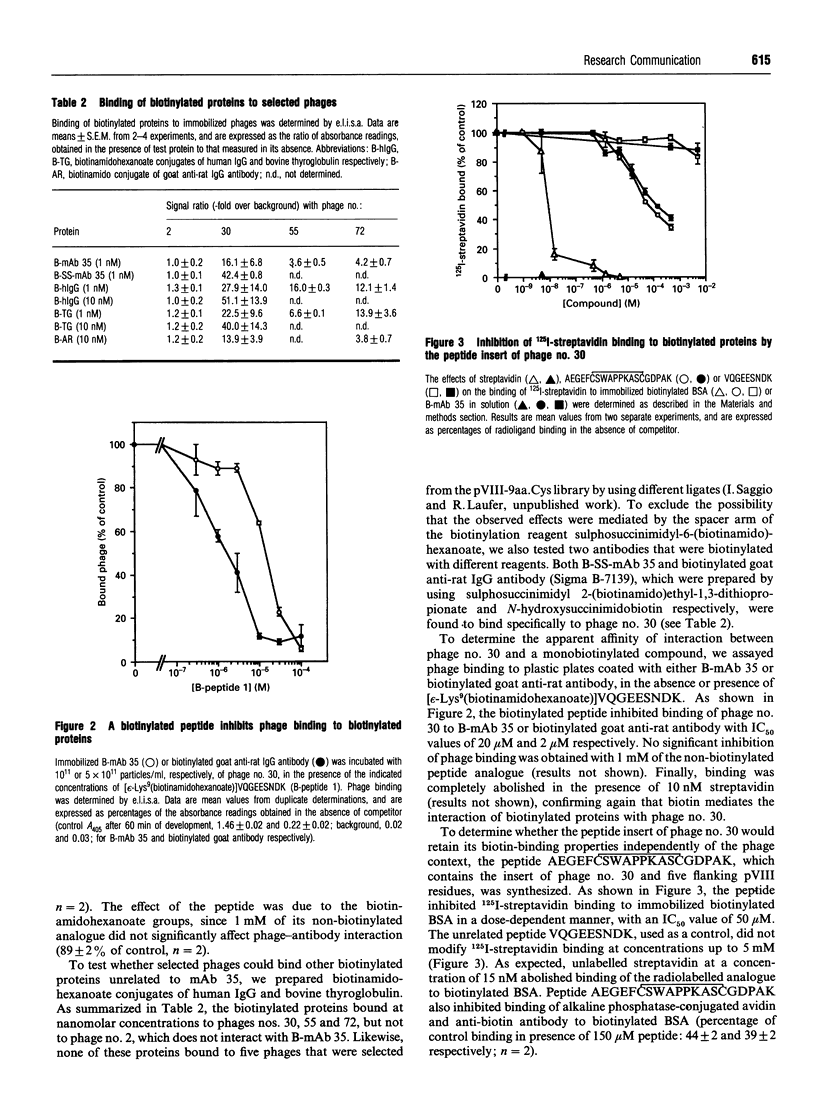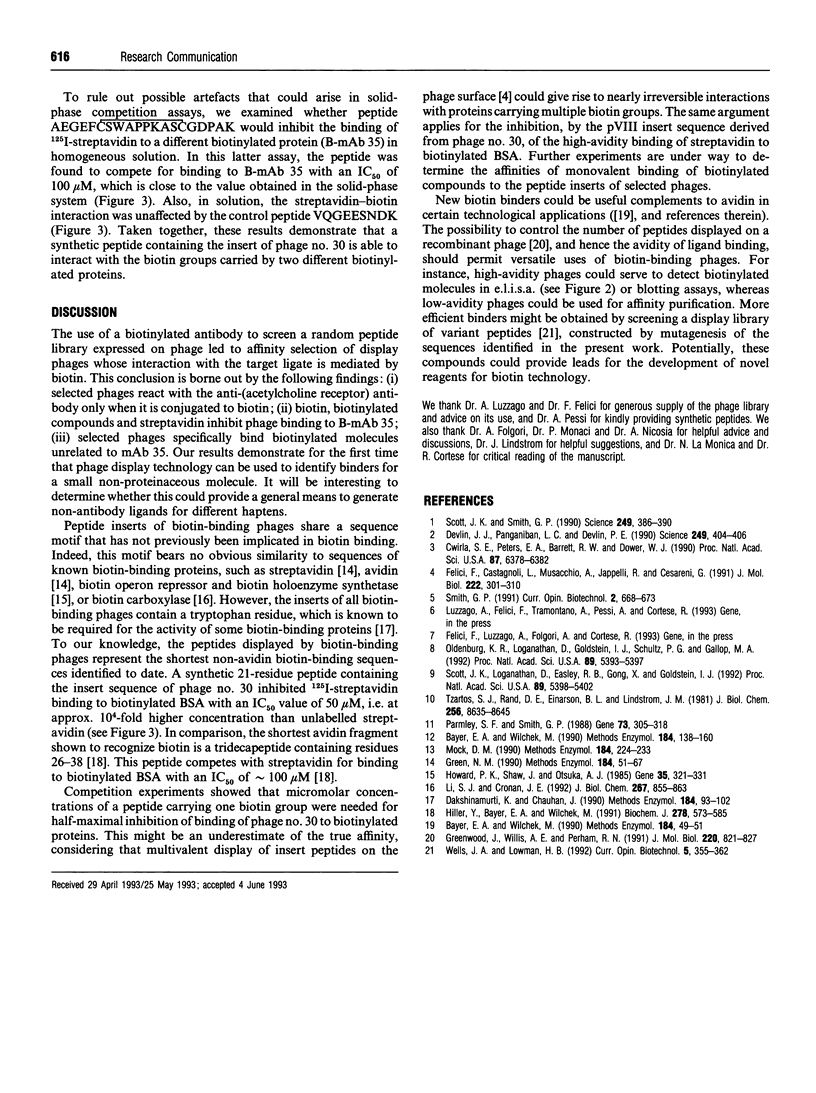Abstract
Recombinant biotin-binding phages were affinity-selected from a random peptide library expressed on the surface of filamentous phage. Phage binding to biotinylated proteins was half-maximally inhibited by micromolar concentrations of a monobiotinylated molecule. Sequencing of the peptide inserts of selected phages led to the identification of a previously unknown biotin-binding motif, CXWXPPF(K or R)XXC. A synthetic peptide containing this sequence motif inhibited streptavidin binding to biotinylated BSA with an IC50 of 50 microM. This compound represents the shortest non-avidin biotin-binding peptide identified to date. Our results illustrate that phage display technology can be used to identify novel ligands for a small non-proteinaceous molecule.
Full text
PDF



Selected References
These references are in PubMed. This may not be the complete list of references from this article.
- Bayer E. A., Wilchek M. Biotin-binding proteins: overview and prospects. Methods Enzymol. 1990;184:49–51. doi: 10.1016/0076-6879(90)84258-i. [DOI] [PubMed] [Google Scholar]
- Bayer E. A., Wilchek M. Protein biotinylation. Methods Enzymol. 1990;184:138–160. doi: 10.1016/0076-6879(90)84268-l. [DOI] [PubMed] [Google Scholar]
- Cwirla S. E., Peters E. A., Barrett R. W., Dower W. J. Peptides on phage: a vast library of peptides for identifying ligands. Proc Natl Acad Sci U S A. 1990 Aug;87(16):6378–6382. doi: 10.1073/pnas.87.16.6378. [DOI] [PMC free article] [PubMed] [Google Scholar]
- Dakshinamurti K., Chauhan J. Nonavidin biotin-binding proteins. Methods Enzymol. 1990;184:93–102. doi: 10.1016/0076-6879(90)84264-h. [DOI] [PubMed] [Google Scholar]
- Devlin J. J., Panganiban L. C., Devlin P. E. Random peptide libraries: a source of specific protein binding molecules. Science. 1990 Jul 27;249(4967):404–406. doi: 10.1126/science.2143033. [DOI] [PubMed] [Google Scholar]
- Felici F., Castagnoli L., Musacchio A., Jappelli R., Cesareni G. Selection of antibody ligands from a large library of oligopeptides expressed on a multivalent exposition vector. J Mol Biol. 1991 Nov 20;222(2):301–310. doi: 10.1016/0022-2836(91)90213-p. [DOI] [PubMed] [Google Scholar]
- Green N. M. Avidin and streptavidin. Methods Enzymol. 1990;184:51–67. doi: 10.1016/0076-6879(90)84259-j. [DOI] [PubMed] [Google Scholar]
- Greenwood J., Willis A. E., Perham R. N. Multiple display of foreign peptides on a filamentous bacteriophage. Peptides from Plasmodium falciparum circumsporozoite protein as antigens. J Mol Biol. 1991 Aug 20;220(4):821–827. doi: 10.1016/0022-2836(91)90354-9. [DOI] [PubMed] [Google Scholar]
- Hiller Y., Bayer E. A., Wilchek M. Studies on the biotin-binding site of avidin. Minimized fragments that bind biotin. Biochem J. 1991 Sep 1;278(Pt 2):573–585. doi: 10.1042/bj2780573. [DOI] [PMC free article] [PubMed] [Google Scholar]
- Howard P. K., Shaw J., Otsuka A. J. Nucleotide sequence of the birA gene encoding the biotin operon repressor and biotin holoenzyme synthetase functions of Escherichia coli. Gene. 1985;35(3):321–331. doi: 10.1016/0378-1119(85)90011-3. [DOI] [PubMed] [Google Scholar]
- Li S. J., Cronan J. E., Jr The gene encoding the biotin carboxylase subunit of Escherichia coli acetyl-CoA carboxylase. J Biol Chem. 1992 Jan 15;267(2):855–863. [PubMed] [Google Scholar]
- Mock D. M. Sequential solid-phase assay for biotin based on 125I-labeled avidin. Methods Enzymol. 1990;184:224–233. doi: 10.1016/0076-6879(90)84278-o. [DOI] [PubMed] [Google Scholar]
- Oldenburg K. R., Loganathan D., Goldstein I. J., Schultz P. G., Gallop M. A. Peptide ligands for a sugar-binding protein isolated from a random peptide library. Proc Natl Acad Sci U S A. 1992 Jun 15;89(12):5393–5397. doi: 10.1073/pnas.89.12.5393. [DOI] [PMC free article] [PubMed] [Google Scholar]
- Parmley S. F., Smith G. P. Antibody-selectable filamentous fd phage vectors: affinity purification of target genes. Gene. 1988 Dec 20;73(2):305–318. doi: 10.1016/0378-1119(88)90495-7. [DOI] [PubMed] [Google Scholar]
- Scott J. K., Loganathan D., Easley R. B., Gong X., Goldstein I. J. A family of concanavalin A-binding peptides from a hexapeptide epitope library. Proc Natl Acad Sci U S A. 1992 Jun 15;89(12):5398–5402. doi: 10.1073/pnas.89.12.5398. [DOI] [PMC free article] [PubMed] [Google Scholar]
- Scott J. K., Smith G. P. Searching for peptide ligands with an epitope library. Science. 1990 Jul 27;249(4967):386–390. doi: 10.1126/science.1696028. [DOI] [PubMed] [Google Scholar]
- Smith G. P. Surface presentation of protein epitopes using bacteriophage expression systems. Curr Opin Biotechnol. 1991 Oct;2(5):668–673. doi: 10.1016/0958-1669(91)90032-z. [DOI] [PubMed] [Google Scholar]
- Tzartos S. J., Rand D. E., Einarson B. L., Lindstrom J. M. Mapping of surface structures of electrophorus acetylcholine receptor using monoclonal antibodies. J Biol Chem. 1981 Aug 25;256(16):8635–8645. [PubMed] [Google Scholar]
- Wells J. A., Lowman H. B. Rapid evolution of peptide and protein binding properties in vitro. Curr Opin Biotechnol. 1992 Aug;3(4):355–362. doi: 10.1016/0958-1669(92)90163-d. [DOI] [PubMed] [Google Scholar]


